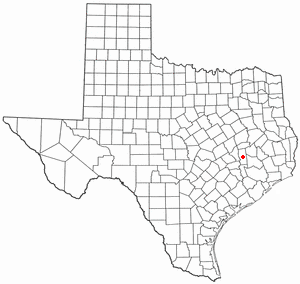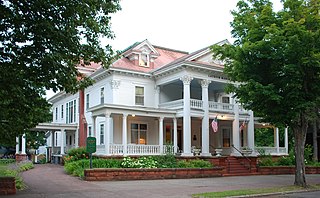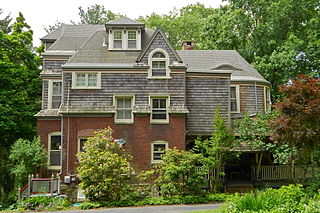
Anderson is a city and county seat of Grimes County, Texas, United States. The population was 193 as of the 2020 census. The town and its surroundings are listed on the National Register of Historic Places as the Anderson Historic District.

Frank Heyling Furness was an American architect of the Victorian era. He designed more than 600 buildings, most in the Philadelphia area, and is remembered for his diverse, muscular, often unordinarily scaled buildings, and for his influence on the Chicago architect Louis Sullivan. Furness also received a Medal of Honor for bravery during the Civil War.

Victorian architecture is a series of architectural revival styles in the mid-to-late 19th century. Victorian refers to the reign of Queen Victoria (1837–1901), called the Victorian era, during which period the styles known as Victorian were used in construction. However, many elements of what is typically termed "Victorian" architecture did not become popular until later in Victoria's reign, roughly from 1850 and later. The styles often included interpretations and eclectic revivals of historic styles (see Historicism). The name represents the British and French custom of naming architectural styles for a reigning monarch. Within this naming and classification scheme, it followed Georgian architecture and later Regency architecture, and was succeeded by Edwardian architecture.

Peabody & Stearns was a premier architectural firm in the Eastern United States in the late 19th century and early 20th century. Based in Boston, Massachusetts, the firm consisted of Robert Swain Peabody (1845–1917) and John Goddard Stearns Jr. (1843–1917). The firm worked on in a variety of designs but is closely associated with shingle style.

The Brush Park Historic District is a neighborhood located in Detroit, Michigan. It is bounded by Mack Avenue on the north, Woodward Avenue on the west, Beaubien Street on the east, and the Fisher Freeway on the south. The Woodward East Historic District, a smaller historic district completely encompassed by the larger Brush Park neighborhood, is located on Alfred, Edmund, and Watson Streets, from Brush Street to John R. Street, and is recognized by the National Register of Historic Places.

Michael Liebel Jr. was the Mayor of Erie, Pennsylvania, from 1906 to 1911, and a Democratic member of the United States House of Representatives from Pennsylvania, from 1915 to 1917.

George Washington Webber was a politician from the U.S. state of Michigan.

The St. Ignace Mission is located in a municipal park known as Marquette Mission Park. It was the site of a mission established by Jesuit priest, Father Jacques Marquette, and the site of his grave in 1677. A second mission was established at a different site in 1837, and the chapel was moved here in 1954. The second mission chapel is the oldest Catholic church in Michigan and Wisconsin. The St. Ignace Mission was designated a Michigan State Historic Site in 1956, and was declared a U.S. National Historic Landmarks in 1960, one of the earliest sites recognized. The mission chapel serves as the Museum of Ojibwa Culture.

The East Ferry Avenue Historic District is a historic residential district in Midtown Detroit, Michigan. The nationally designated historic district stretches two blocks from Woodward Avenue east to Brush Street; the locally designated historic district includes a third block between Brush and Beaubien. The district includes the separately designated Col. Frank J. Hecker House and the Charles Lang Freer House. It was designated a Michigan State Historic Site in 1976 and listed on the National Register of Historic Places in 1980.

Wilson Brothers & Company was a prominent Victorian-era architecture and engineering firm established in Philadelphia, Pennsylvania. The company was regarded for its structural expertise. The brothers designed or contributed engineering work to hundreds of bridges, railroad stations and industrial buildings, including the principal buildings at the 1876 Centennial Exposition. They also designed churches, hospitals, schools, hotels and private residences. Among their surviving major works are the Pennsylvania Railroad, Connecting Railway Bridge over the Schuylkill River (1866–67), the main building of Drexel University (1888–91), and the train shed of Reading Terminal (1891–93), all in Philadelphia.

The Thomas H. Hoatson House is a house located at 320 Tamarack Street in Laurium, Michigan. It was listed on the National Register of Historic Places in 1994. At 13,000 square feet (1,200 m2), it is the largest mansion in the western Upper Peninsula of Michigan.

The Charles G. Curtiss Sr. House is a private home at 168 S. Union St. in Plymouth, Michigan in the United States. It was listed on the National Register of Historic Places in 1993 and designated a Michigan State Historic Site in 1994.

The Sheldon Inn was a two-story apartment building located at 44134 Michigan Avenue, in Sheldon Corners in Canton Township, Michigan. It was built in 1825, and previously used as a single-family home and a travelers' inn. It was listed on the National Register of Historic Places in 2000. It was demolished in 2021.

The East River Road Historic District is a historic district located along East River Road near the Grosse Ile Parkway in Grosse Ile, Michigan. The district includes eleven structures, including seven houses, two outbuildings, St. James Episcopal Church, and the Michigan Central Railroad depot. The district stretches from St. James Episcopal Church on the south to Littlecote on the north. The district was designated a Michigan State Historic Site in 1972 and listed on the National Register of Historic Places in 1973. The historically significant 1870s customs house was moved into the district in 1979.

The Grand Pacific Hotel is a historic building in Seattle, Washington located at 1115-1117 1st Avenue between Spring and Seneca Streets in the city's central business district. The building was designed in July 1889 and constructed in 1890 [Often incorrectly cited as 1898] during the building boom that followed the Great Seattle Fire of 1889. Though designed as an office building, the Grand Central had served as a Single room occupancy hotel nearly since its construction, with the Ye Kenilworth Inn on the upper floors during the 1890s. The hotel was refurnished and reopened in 1900 as the Grand Pacific Hotel, most likely named after the hotel of the same name in Chicago that had just recently been rebuilt. It played a role during the Yukon Gold Rush as one of many hotels that served traveling miners and also housed the offices for the Seattle Woolen Mill, an important outfitter for the Klondike.

Idlewild is a historic building near Media, Pennsylvania, designed by the Victorian-era Philadelphia architect Frank Furness as a summer cottage for his family. He spent summers there until his death in 1912.

The Captain William Bull Tavern is a historic inn at 571 Torrington Road in Litchfield, Connecticut. It is part of the Tollgate Hill Inn and Restaurant, and is listed on the National Register of Historic Places. It is significant both as an excellent local example of Colonial architecture, and for its role in early architectural preservation efforts in the region.

The Westside Neighborhood Historic District is a residential historic district, located along West Maple, and West Ash Street between South McRoberts Street and the railroad grade east of Sycamore Creek in Mason, Michigan. It also includes The district was listed on the National Register of Historic Places in 1985.

The Richland Historic District is a commercial and residential historic district located in the center of Richland, Michigan, containing structures near the intersection of 32nd Street, D Avenue, and Gull Road. The district was listed on the National Register of Historic Places in 1997.

Historic Hotels of America is a program of the National Trust for Historic Preservation that was founded in 1989 with 32 charter members; the program accepts nominations and identifies hotels that have maintained their authenticity, sense of place, and architectural integrity. In 2015, the program included over 260 members in 44 states, including the District of Columbia, Puerto Rico, and the U.S. Virgin Islands. In 2022, the program includes 273 hotels. This article lists current and former member hotels.



















